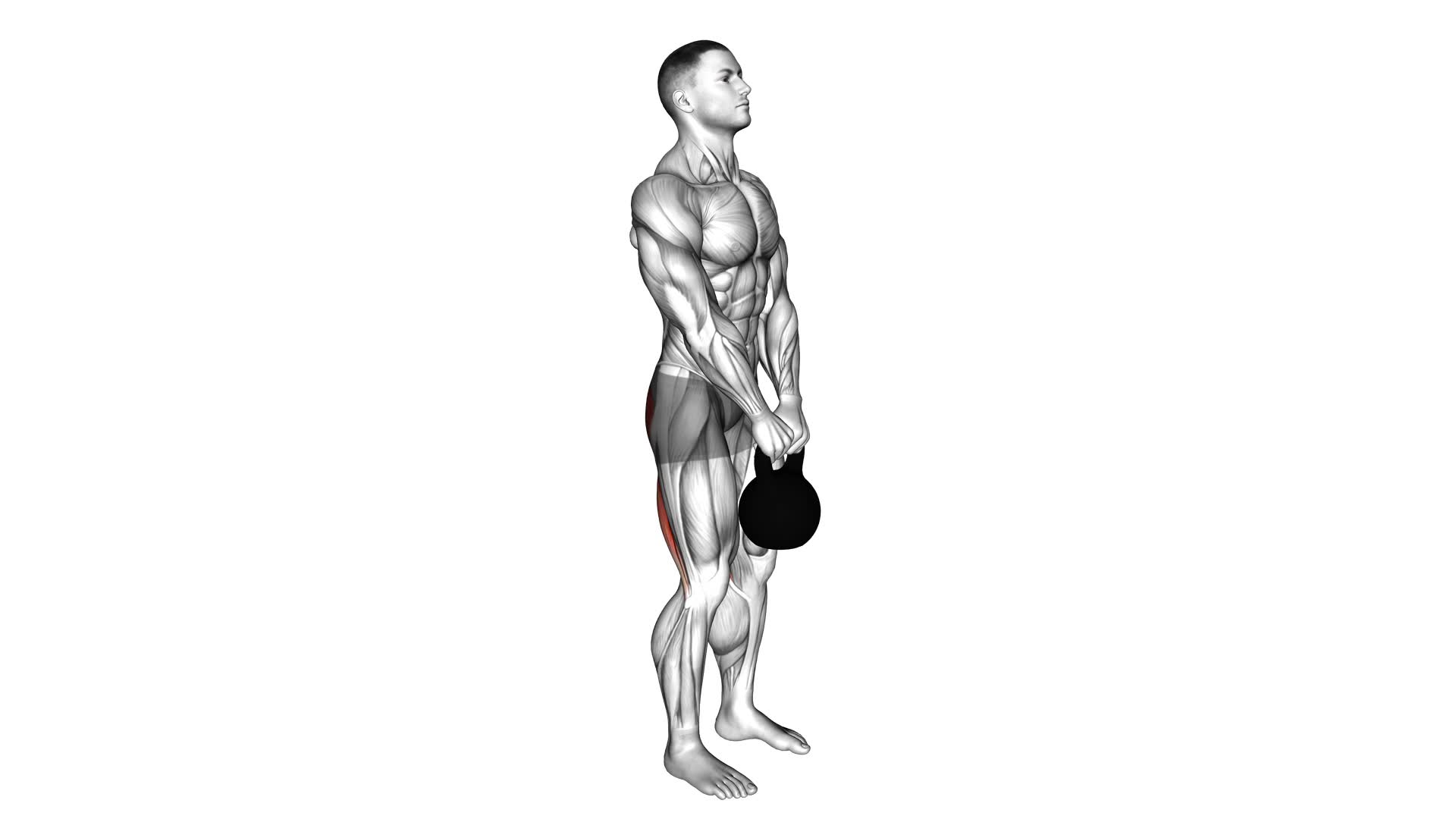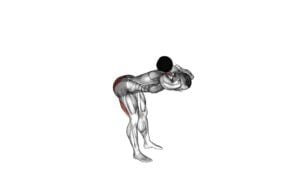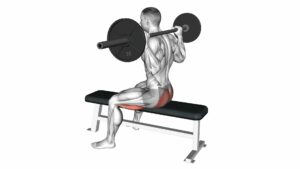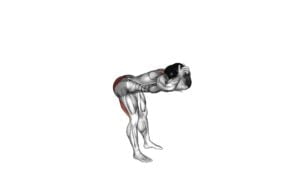Kettlebell Good Morning – Video Exercise Guide & Tips

Are you looking for a quick and effective exercise to strengthen your lower back and glutes? Look no further than the kettlebell good morning!
Watch This Exercise Video
In this video exercise guide, we'll show you the proper form and technique, as well as provide tips and modifications for different fitness levels.
Whether you're a beginner or a seasoned gym-goer, incorporating the kettlebell good morning into your workout routine will help you achieve a stronger and more toned posterior chain.
Let's get started!
Key Takeaways
- The kettlebell good morning exercise improves hamstring and glute strength while targeting posterior chain muscles.
- Proper form and technique are crucial to prevent injuries and maintain stability and control throughout the movement.
- Choosing the right kettlebell weight is essential, considering the ideal weight range and personal fitness level, and gradually increasing the weight as strength improves.
- Common mistakes to avoid include rounding the back, lifting the kettlebell with the arms, allowing knees to straighten completely, and failing to engage the core muscles.
Benefits of the Kettlebell Good Morning
Benefits of the Kettlebell Good Morning include improved hamstring and glute strength by incorporating a dynamic hip hinge movement. This exercise is highly effective in targeting the posterior chain muscles, which are essential for overall lower body strength and stability. By performing the Kettlebell Good Morning, you can significantly improve your hip mobility and increase your hamstring strength.
The dynamic hip hinge movement involved in the Kettlebell Good Morning helps to stretch and strengthen the hamstrings, which play a crucial role in various movements such as running, jumping, and squatting. As you bend forward at the hips, the hamstrings are lengthened and then contracted forcefully to bring you back to an upright position. This repetitive action helps to increase the strength and endurance of the hamstrings.
Additionally, the Kettlebell Good Morning also improves hip mobility. The movement requires a good range of motion in the hips, forcing them to move through a full range of motion. This can help to increase flexibility and reduce the risk of injuries in the hips and lower back.
Incorporating the Kettlebell Good Morning into your workout routine can be highly beneficial for improving hip mobility and increasing hamstring strength. It's a challenging exercise that targets important muscles in the lower body, leading to improved overall strength and performance.
Proper Form and Technique for the Exercise
To perform the Kettlebell Good Morning exercise correctly, you should start by selecting an appropriate kettlebell weight that challenges you without compromising your form. Proper form and technique are essential to prevent injury and maximize the benefits of this exercise.
Here are some tips to help you perform the Kettlebell Good Morning with proper form:
- Position your feet hip-width apart and hold the kettlebell with both hands in front of your chest.
- Engage your core and keep your back straight throughout the exercise.
- Hinge at the hips, pushing your glutes back as you lower your upper body towards the ground.
- Maintain a slight bend in your knees and focus on feeling the stretch in your hamstrings.
Common mistakes to avoid include rounding your back, lifting the kettlebell with your arms, and allowing your knees to straighten completely. Remember to start with a lighter weight and gradually increase as you build strength and master the technique.
Modifications and variations can be made based on your fitness level and goals. You can perform the Kettlebell Good Morning with one kettlebell held in one hand, or try using resistance bands for added resistance. Always listen to your body and adjust the exercise accordingly.
Proper form and technique are key to getting the most out of the Kettlebell Good Morning.
Choosing the Right Kettlebell Weight
When it comes to choosing the right kettlebell weight, there are two main factors to consider: the ideal weight range and your personal fitness level.
The ideal weight range can vary depending on your goals, but generally, beginners should start with a lighter kettlebell and gradually increase the weight as they become more comfortable and proficient with the exercises.
Your personal fitness level also plays a role in determining the appropriate weight, as more advanced individuals may be able to handle heavier kettlebells.
Ideal Weight Range
Choose a kettlebell weight that's appropriate for your fitness level and goals. When determining the ideal weight range for your kettlebell, consider the following:
- Start with a weight that allows you to perform exercises with proper form and technique.
- Gradually increase the weight as you become stronger and more comfortable with the movements.
- If your goal is weight loss, choose a kettlebell that challenges you but still allows you to perform high-intensity exercises.
- Maintain a healthy diet to support your weight loss goals and overall fitness.
Choosing the right kettlebell weight is crucial for achieving your desired results. Once you have determined the ideal weight range, you can move on to assessing your personal fitness level and tailoring your workouts accordingly.
Personal Fitness Level
Assess your current fitness level to determine the appropriate kettlebell weight for your workouts. It's important to choose a weight that challenges you, but also allows you to maintain proper form and technique.
Consider your fitness goals and the intensity of your workouts when selecting a kettlebell weight. If you're a beginner or have limited strength and endurance, start with a lighter weight and gradually increase as you become more comfortable and stronger.
On the other hand, if you're more experienced and looking for a higher intensity workout, you may opt for a heavier kettlebell. Remember, it's essential to listen to your body and not push yourself beyond your limits to avoid injury and promote overall fitness progress.
Common Mistakes to Avoid
To prevent injury and maximize the effectiveness of your kettlebell good morning exercise, it's essential that you focus on avoiding common mistakes. Proper alignment plays a crucial role in performing this exercise correctly. Here are some common mistakes to avoid:
- Poor posture: Maintaining a neutral spine is essential. Avoid rounding your back or arching it excessively.
- Dropping the kettlebell: Control is key. Avoid swinging the kettlebell too forcefully or letting it drop too low, as this can strain your lower back.
- Lack of core engagement: Engaging your core muscles helps stabilize your body and protect your lower back. Be sure to activate your core throughout the entire movement.
- Overextending your neck: Keep your neck in a neutral position, aligned with your spine. Avoid looking up or tucking your chin too much.
By paying attention to these common mistakes and focusing on proper alignment, you can ensure that you perform the kettlebell good morning exercise safely and effectively.
Remember to start with a lighter weight and gradually increase as you gain strength and confidence in your form. Happy exercising!
Modifications and Variations for Different Fitness Levels
To accommodate different fitness levels and goals, there are several modifications and variations you can incorporate into the kettlebell good morning exercise. If you're just starting out or have limited mobility, you can perform the exercise without any weights to focus on proper form and technique. This will help build strength and stability in your lower back and hips.
As you progress, you can gradually add weight to challenge yourself and increase the intensity of the exercise.
For those looking for more advanced variations, you can try performing the kettlebell good morning on a stability ball or BOSU ball. This will engage your core muscles even more as you work to maintain balance. Another option is to perform the exercise with a single leg, which will further challenge your stability and strength.
Remember to always listen to your body and choose the modifications and variations that are appropriate for your fitness level. It's important to start with proper form and gradually progress to more advanced variations to prevent injury.
Now that you know about the different fitness modifications and advanced variations, let's move on to the next section for some tips on how to incorporate the kettlebell good morning into your workout routine.
Tips for Incorporating the Kettlebell Good Morning Into Your Workout Routine
To incorporate the kettlebell good morning into your workout routine, start by selecting an appropriate weight and ensuring proper form and technique. Here are some tips to help you incorporate this exercise effectively:
- Warm up: Before starting any workout, it's important to warm up your body. Perform dynamic stretches and light cardio exercises to increase blood flow and prepare your muscles for the workout ahead.
- Start with lighter weights: If you're new to the kettlebell good morning, begin with lighter weights to practice proper form and technique. As you become more comfortable and confident, gradually increase the weight.
- Incorporate kettlebell swings: The kettlebell good morning exercise can be complemented by incorporating kettlebell swings into your routine. This will help strengthen your posterior chain and improve your overall performance.
- Listen to your body: Pay attention to how your body feels during the exercise. If you experience any pain or discomfort, stop immediately. Adjust your form or weight as needed to prevent injury.
Frequently Asked Questions
Can the Kettlebell Good Morning Help Improve Posture?
The kettlebell good morning is a great exercise for improving posture. By targeting the muscles in your back, glutes, and hamstrings, it helps strengthen and stabilize your core.
This, in turn, can lead to better posture and alignment. When performing the kettlebell good morning, make sure to maintain proper form and engage your core throughout the movement.
This will ensure maximum benefits and minimize the risk of injury.
Is It Safe to Perform the Kettlebell Good Morning Exercise if I Have Lower Back Pain?
If you have lower back pain, it's important to approach the kettlebell good morning exercise with caution. While it can be beneficial for improving posture, it may put additional strain on your lower back.
It's crucial to listen to your body and consult with a healthcare professional before attempting this exercise. There are alternative exercises that can help strengthen your core and improve posture without aggravating your lower back pain.
How Many Sets and Reps Should I Do When Incorporating the Kettlebell Good Morning Into My Workout Routine?
When incorporating the kettlebell good morning into your workout routine, it's important to consider your workout intensity and goals.
The number of sets and reps can vary depending on your fitness level and desired outcomes. Start with 2-3 sets of 8-12 reps and gradually increase as you get stronger.
Remember, kettlebell exercises offer numerous benefits such as improving core strength, enhancing flexibility, and targeting multiple muscle groups simultaneously.
Make sure to maintain proper form and listen to your body to prevent injury.
Can the Kettlebell Good Morning Exercise Help Increase Flexibility?
The kettlebell good morning exercise is a great way to increase flexibility. By incorporating this exercise into your routine, you can reap the benefits of improved range of motion and mobility.
The technique involves hinging at the hips while keeping a slight bend in your knees and maintaining a neutral spine.
With regular practice, you'll notice significant improvements in your flexibility, making it easier to perform other exercises and daily activities.
Are There Any Alternatives to the Kettlebell Good Morning Exercise That Target Similar Muscle Groups?
Looking for alternative exercises that target similar muscle groups as the kettlebell good morning? There are plenty of options to choose from.
Incorporating exercises like Romanian deadlifts, hip hinges, or single-leg deadlifts into your routine can provide similar benefits. These exercises focus on strengthening your posterior chain and improving hip mobility, just like the kettlebell good morning.
Conclusion
Incorporating the kettlebell good morning into your workout routine can offer numerous benefits. This exercise is particularly effective for strengthening your posterior chain and improving your hip mobility. By following proper form and technique, you can maximize the effectiveness of this exercise.
Choosing the right kettlebell weight is also important. Start with a lighter weight and gradually increase as you become more comfortable and confident with the movement.
Avoiding common mistakes is crucial to prevent injury. Some common mistakes include rounding your back, lifting too heavy of a weight, and not engaging your core. Be mindful of these mistakes and focus on maintaining proper form throughout the exercise.
Modifications and variations of the kettlebell good morning allow individuals of all fitness levels to participate. Beginners can start with bodyweight good mornings or use a lighter kettlebell, while more advanced individuals can increase the weight or try single-leg variations.
Remember to consult a fitness professional before attempting any new exercise, including the kettlebell good morning, to ensure safety and proper execution. They can provide guidance, check your form, and help you tailor the exercise to your specific needs and goals.

Author
Years ago, the spark of my life’s passion ignited in my mind the moment I stepped into the local gym for the first time. The inaugural bead of perspiration, the initial endeavor, the very first surge of endorphins, and a sense of pride that washed over me post-workout marked the beginning of my deep-seated interest in strength sports, fitness, and sports nutrition. This very curiosity blossomed rapidly into a profound fascination, propelling me to earn a Master’s degree in Physical Education from the Academy of Physical Education in Krakow, followed by a Sports Manager diploma from the Jagiellonian University. My journey of growth led me to gain more specialized qualifications, such as being a certified personal trainer with a focus on sports dietetics, a lifeguard, and an instructor for wellness and corrective gymnastics. Theoretical knowledge paired seamlessly with practical experience, reinforcing my belief that the transformation of individuals under my guidance was also a reflection of my personal growth. This belief holds true even today. Each day, I strive to push the boundaries and explore new realms. These realms gently elevate me to greater heights. The unique combination of passion for my field and the continuous quest for growth fuels my drive to break new ground.







